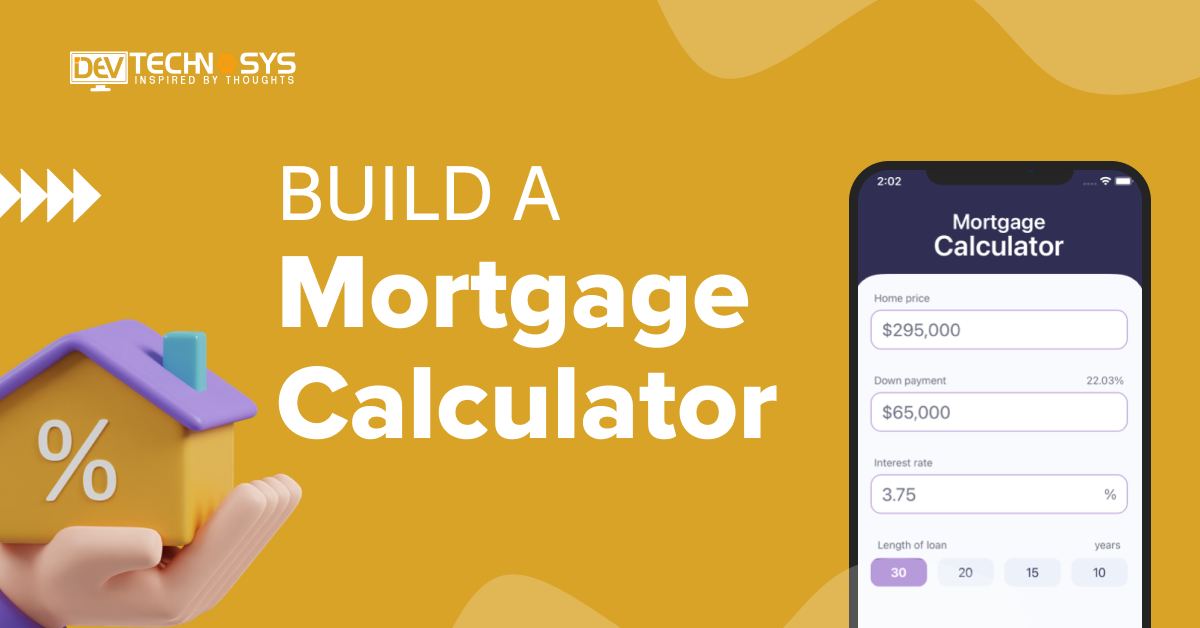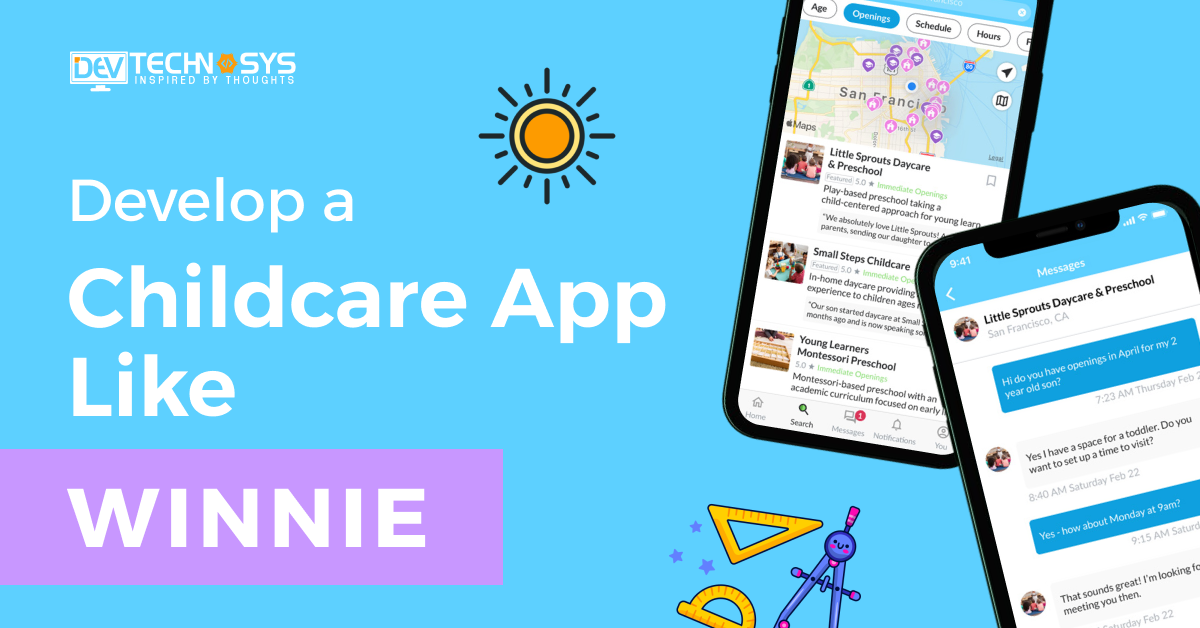“Manage your business profit by creating a mortgage calculator at low cost.”
Confused on how to get a home loan? Try a mortgage calculator to predict your financial balance and EMI estimates. For a business investor, it is beneficial to build a mortgage calculator tool for users looking to identify loan amounts for property loans. These tools have remarkable applications in the fintech industry helping users in all aspects.
Key takeaways:
-
- You can easily list app features considering user preferences.
- Use the process to develop mortgage calculators.
- Make budget calculations for maintenance and security.
- Make revenue through brand listing and user engagement
The finance and banking market is booming every quarter with an increase in users. So, the idea to create a mortgage calculator for the modern generation is beneficial, but requires a thorough development plan. You need a reliable source in this case.
In this blog, we will discuss all the related points and topics to help you in developing a reliable and excellent mortgage calculator tool.
Market Stats for Property Loans & Financing
Rising desires for homeownership and developments in digital fintech are driving significant expansion in the real estate loan and financing market. The industry’s trajectory is being reshaped by technological advancements and market expansion.
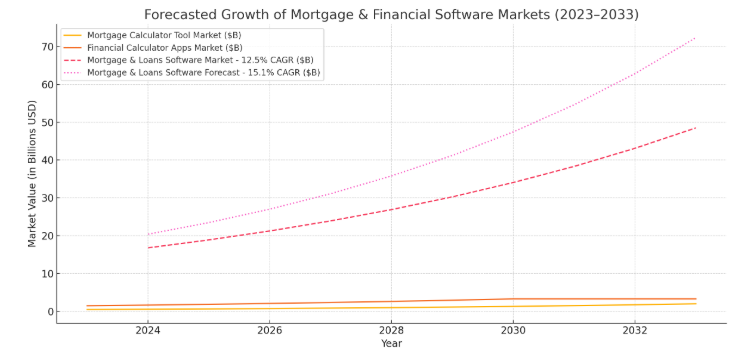
- Mortgage calculator tool market is valued at approximately $500 Million, projected to grow at a robust 15% CAGR through 2033.
- Global financial calculator apps reached around $1.5 Billion in 2023, expanding at a 12% CAGR through 2030.
- Mortgage & loans software market estimated at $16.8 Billion in 2024, on track for $48.5 Billion by 2033, achieving around 12.5% CAGR rate.
- Mortgage and loans software forecast to grow from $20.4 Billion in 2024 to $23.5 Billion by 2025, and reach $73.2 Billion by 2033, with 15.1% CAGR rate.
- U.S. mortgage debt owe $12.80 Trillion across 85.8 Million mortgages, averaging $149,266 per mortgage account.
What is a Mortgage Calculator App?
A mortgage calculator app is a computerized application that assists users in estimating their monthly mortgage payments. The tool uses information such as loan amount, interest rate, term, and down payment. You may create a website from scratch to streamline intricate financial computations. This will facilitate precise and convenient budget planning with loan option evaluation for homebuyers and real estate investors.
- Calculates monthly payments, total interest, and amortization schedules.
- Helps users compare multiple loan scenarios instantly.
- Often includes tax, insurance, and PMI estimations for accurate budgeting.
Benefits of Mortgage Calculator Development
You can create a mortgage calculator to enhance business objectives and provide useful features. It strengthens brand dependability, expedites consumer connection, and enhances user experience:
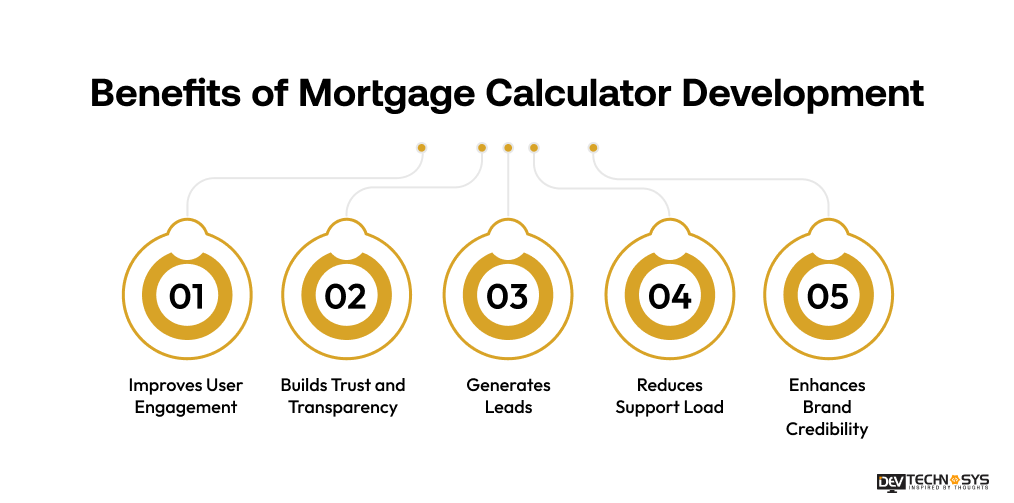
1. Improves User Engagement
An interactive mortgage calculator that provides instantaneous estimates keeps consumers interested in your platform. By changing the loan amount, length, and interest rate, users can investigate different lending scenarios. So, first you must know the cost to build mortgage calculator.
2. Builds Trust and Transparency
Giving them up-front, transparent cost breakdowns increases their trust in your offerings. A calculator makes procedures transparent by displaying monthly payments, interest rates, and total expenses in detail. As a business investor, you must understand the cost to build a mortgage calculator before investing.
3. Generates Leads
Through optional form submissions or quotation requests, mortgage calculators have the ability to collect user data. They turn visitors into possible leads by providing immediate results in return for little work. It is necessary to avail custom website development services for online data gathering.
4. Reduces Support Load
The calculator allows users to independently find solutions to frequently asked loan-related questions. Repetitive customer support includes EMI or payment breakdowns. Businesses may get mortgage calculator development services to decrease self-service application cost.
5. Enhances Brand Credibility
Providing a well-designed calculator offers value and demonstrates your company’s customer-focused and tech-savvy approach. It establishes your company as a reliable and beneficial source in the financial industry. So, it is beneficial to develop a mortgage calculator for users.
Use of AI in Mortgage Calculator Apps
Apps for mortgage calculators are changing as a result of artificial intelligence, becoming more efficient, predictive, and personalized. AI improves user experience by supporting decision-making, automating tasks, and analyzing data intelligently. You may hire a custom mobile app development company to increase accuracy and engagement. It will help in streamlining intricate financial procedures and assisting users in gaining deeper insights with AI.
- Predicts loan approval chances based on user data and credit history.
- Recommends personalized loan options using machine learning algorithms.
- Uses natural language processing for chatbot or voice assistant interactions.
- Analyzes spending behavior to estimate realistic affordability.
- Detects potential fraud or errors through pattern recognition.
How to Make a Mortgage Calculator Application?
The target to build a mortgage calculator must be completed timely to prevent financial losses and get market benefits. Here, we will see the major steps used in the development process:
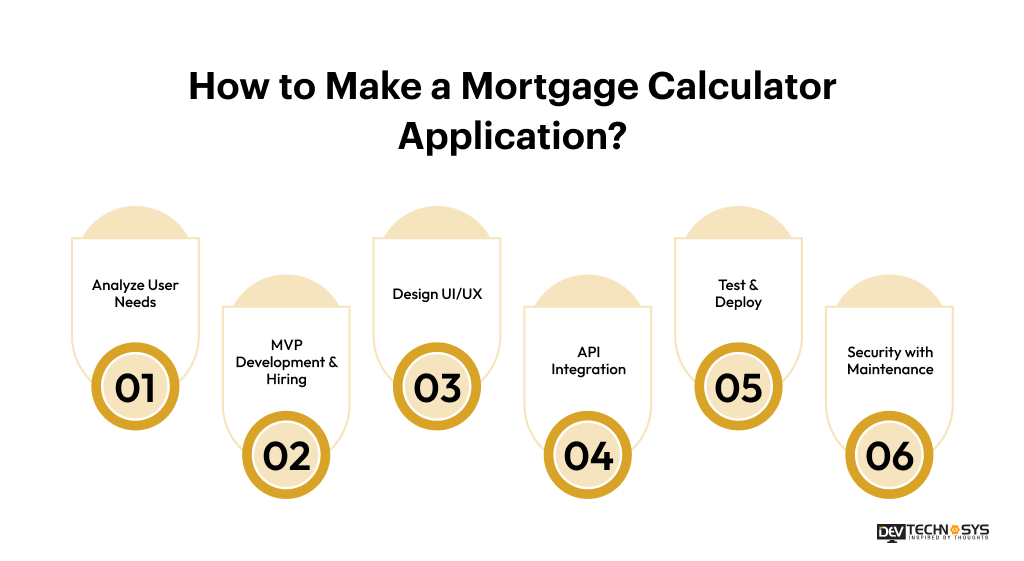
1. Analyze User Needs
Start by determining market audiences, such as financial advisors, real estate brokers, or homebuyers. Recognize frequently asked questions about loans, such as affordability, interest rates, and EMI projections. Examine rival apps to identify any issues or missing features.
List the essential features that users want like loan comparisons. Ask prospective users for their opinions by conducting interviews or surveys to easily develop a mortgage calculator.
2. MVP Development & Hiring
Describe the features of the MVP like the calculating logic, basic results display, and loan entry areas. To create a mortgage calculator, you must hire intelligent developers from a mobile banking app development company at lower rates.
Use front-end technology stacks like React, Flutter, or Swift that are appropriate for web or mobile applications. Make that real-time computations and data processing are handled by backend logic.
3. Design UI/UX
Create user-friendly interfaces that make complicated computations easier for users. Make sure the input fields such as interest rate, term, or loan amount are labelled properly. You should make a mortgage calculator with visual aids like pie charts, amortization graphs, and sliders.
If creating a web version, give mobile responsiveness first priority. Make prototypes and wireframes with programs like Adobe XD or Figma.
4. API Integration
Incorporate APIs for currency translation, real-time interest rate data, and location-based user modifications. Enhance functionality with third-party APIs, such as pre-checks for loan approval, tax estimators, and payment schedules.
Make sure APIs adhere to financial data standards that are safe. You may approach a mortgage calculator development company to integrate with internal CRMs or banks and use custom APIs.
5. Test & Deploy
Perform testing methods like unit, user interface, functional, and load testing, on a variety of screens and devices. Find and address flaws pertaining to display problems, computation errors, or input handling. Testing user situations like offline mode and fast toggling may increase the website development cost.
For early input, conduct beta testing with a small user population. Deploy on favored platforms, such as web hosting services or iOS and Android, after it is stable.
6. Security with Maintenance
Encrypt user data, provide secure API connections, and adhere to data storage regulations. If necessary, use secure authentication techniques like OAuth to implement login choices. Update the app frequently to ensure it works with new frameworks and OS versions.
Keep an eye out for bugs, security flaws, and performance problems at all times. Plan regular backups and, if you can, turn on automatic upgrades.
Types of Mortgage Calculators
There are several types of mortgage calculators that meet particular requirements for financial planning. They assist users in planning refinances, estimating payments, and determining affordability:
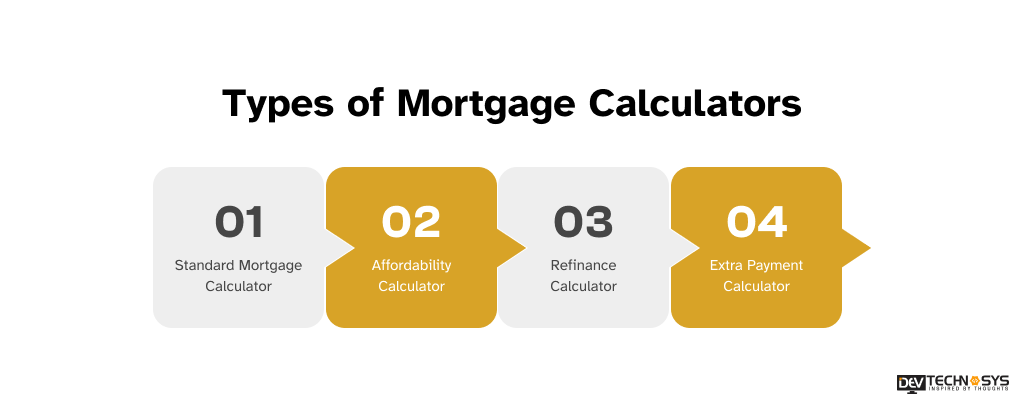
1. Standard Mortgage Calculator
Using the loan amount, interest rate, and term, this monthly mortgage calculator assists users in estimating their monthly mortgage payments. Principal and interest are usually included, and taxes and insurance may also be taken into account.
2. Affordability Calculator
Based on income, debt, expenses, and interest rates, this calculator calculates the amount of a home a user can afford. Before beginning their property hunt, it assists consumers in creating reasonable budgets.
3. Refinance Calculator
The cost of a new mortgage and the user’s existing loan are compared via a refinance calculator. It assists in figuring out refinancing will result in cheaper monthly payments or eventually lower total interest. You may build an app like Klarna that is the best example of this type.
4. Extra Payment Calculator
This commercial mortgage calculator illustrates how making extra payments on a monthly or lump sum basis can shorten the loan term and lower interest rates. It’s perfect for consumers who wish to save money and pay off their mortgage more quickly.
Basic Features of Mortgage Calculators
Essential components that make home loan planning easy are included in mortgage calculators. With these tools, users may enter important information to get precise and updated estimations:
| Features | Description |
| Loan Amount Input | Allows users to enter the total amount they plan to borrow for their home purchase. |
| Interest Rate Input | Enables users to input the expected or offered interest rate to calculate accurate repayment amounts. |
| Loan Term Selection | Lets users choose the loan duration to see the effect of the years on monthly payments. |
| Monthly Payment Calculation | Automatically calculates monthly principal and interest payments based on the input data. |
| Amortization Schedule Display | Shows a breakdown of each payment over time, indicating how much goes toward interest and principal. |
| Down Payment Input | Allows users to enter the upfront payment amount, which reduces the overall loan size and monthly cost. |
| Property Tax Estimation | Estimates annual property taxes and includes them in the total monthly housing cost. |
| Insurance Cost Inclusion | Adds homeowner’s insurance to monthly expenses for a more complete financial picture. |
| Private Mortgage Insurance (PMI) Estimator | Calculates PMI costs if the down payment is below a certain threshold. |
| Graphical Payment Breakdown | Displays a visual chart or pie graph to help users understand the composition of their monthly payments. |
Advanced Features of a Property Loan App
Modern property lending apps provide real-time features that go beyond simple computations. These products leverage AI and automation to streamline the lending process and tailor the user experience:
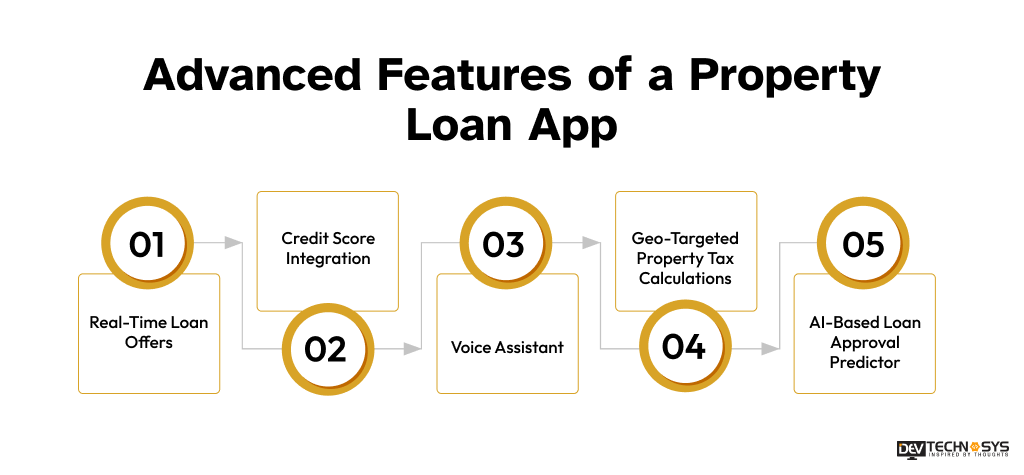
1. Real-Time Loan Offers
A mortgage loan calculator displays personalized loan offers from banks or lenders based on user input and eligibility. Users can compare rates, terms, and lenders instantly within the app.
2. Credit Score Integration
Afterpay is the best mortgage calculator app integrated with credit bureaus to fetch real-time credit scores. This feature helps users understand their borrowing capacity and chances of approval.
3. Voice Assistant
These calculators enable users to interact with the app using voice commands for hands-free calculations or queries. You may develop loan apps like LazyPay to improve accessibility and user experience.
4. Geo-Targeted Property Tax Calculations
Automatically adjusts property tax estimates based on the user’s location or selected property area. This ensures more accurate monthly cost projections for region-specific planning.
5. AI-Based Loan Approval Predictor
It uses AI to analyze user data and predict mortgage approval. You may develop a mortgage calculator to provide instant feedback and suggestions to improve approval chances.
Top 10 Leading Mortgage Calculator Apps
Various mortgage amortization calculator applications are necessary for both purchasers and real estate agents. These apps give consumers precise payment projections and budgeting insights. These are the top ten most popular mortgage calculator apps, which are renowned for their functionality and intuitive user interfaces:
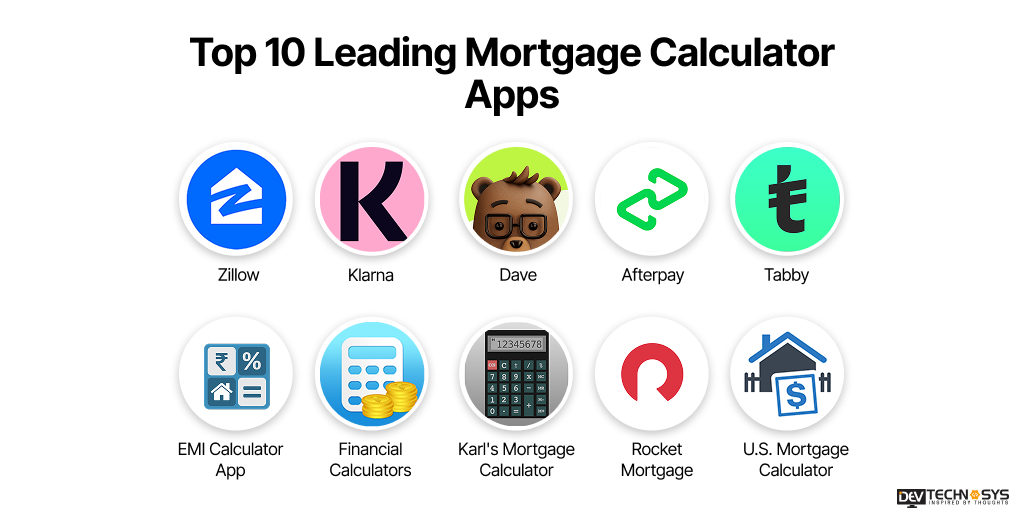
| Top 10 Mortgage Calculator Apps | Supported Devices | Downloads | Ratings |
| Zillow | Android|iOS | 50M+ | 4.7 |
| Klarna | Android|iOS | 50M+ | 4.6 |
| Dave | Android|iOS | 10M+ | 5.0 |
| Afterpay | Android|iOS | 10M+ | 3.9 |
| Tabby | Android|iOS | 5M+ | 4.7 |
| EMI Calculator App | Android|iOS | 5M+ | 4.5 |
| Financial Calculators | Android|iOS | 5M+ | 4.3 |
| Karl’s Mortgage Calculator | Android|iOS | 1M+ | 4.1 |
| Rocket Mortgage | Android|iOS | 1M+ | 3.9 |
| U.S. Mortgage Calculator | Android|iOS | 100K+ | 3.9 |
User Case Study: Zillow App
If you are looking to build a buy now pay later app like Afterpay, then you must go through this section to know more about users’ favorite Zillow app.
- Founder and Launch Date: Zillow was founded by Rich Barton and Lloyd Frink, with its website launching on February 8, 2006.
- Origin of Launch: Conceived by former Expedia executives in Seattle, Zillow began to democratize real‑estate valuation by offering Zestimate tools and public home data.
- Business and Market Expansion: The company expanded with acquisitions of Trulia (2015), StreetEasy, HotPads, and built a mortgage marketplace in 2008, entering Canada by 2018.
- Past and Current Revenue: Zillow’s annual revenue grew from about $1.95 Billion in 2023 to $2.23 Billion in 2024.
- Growth Rate with Future Estimation: In Q4 2024, total revenue rose by 17%, while mortgages revenue surged 86%. Zillow anticipates mid‑teens percentage growth in 2025 as it expands.
How Does a Mortgage Calculator Benefit Users?
You can develop a mortgage calculator that allows consumers to easily make well-informed financial decisions. The tool provides instant access to information about monthly payments and loan terms:
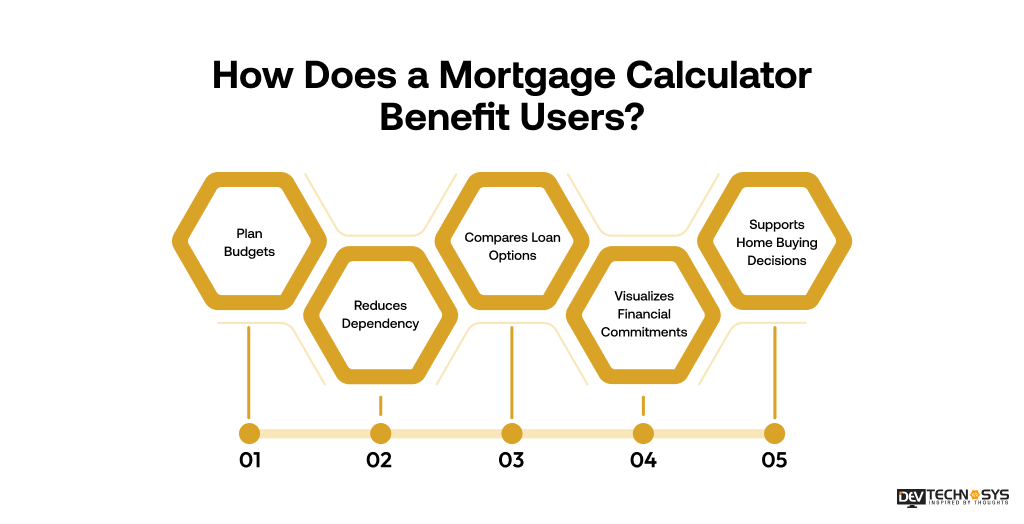
1. Plan Budgets
Using their income and costs, users can determine their borrowing limit. Afterpay is the best android mortgage calculator app that helps users to develop a reasonable home-buying budget. It encourages more prudent financial planning and discourages excessive spending.
2. Reduces Dependency
Various top apps like Afterpay reduce the need for ongoing conversations with financial consultants by providing fast findings. Users can save time and effort by individually exploring multiple situations. It encourages decision-making confidence and financial literacy.
3. Compares Loan Options
To compare several loan offers, users can enter various interest rates, loan conditions, or down payments. This makes it possible for them to identify the most affordable and feasible financing choice. A home mortgage calculator assists in avoiding expensive or unfavorable lending arrangements.
4. Visualizes Financial Commitments
Mortgage calculators provide principal vs. interest graphs and comprehensive payment plans. Over time, this aids users in comprehending the entire extent of their financial responsibilities. You can build an app like Dave that guarantees that the repayment plan and long-term planning are clear.
5. Supports Home Buying Decisions
Users can determine whether a particular property fits within their budget by using precise cost estimates. It helps individuals make sensible decisions and stops them from making rash or emotional purchases. A mortgage affordability calculator provides more certain and smart purchasing choices.
Necessary Tech Stack to Develop a Mortgage Calculator
A carefully considered tech stack is necessary to develop an app like KOHO which is a mortgage calculator tool. Every element, from backend processing and third-party connectors to frontend interfaces, is essential. A table outlining the necessary elements and the suggested tools or technologies for each can be found below:
| Component | Recommended Tools/Technologies |
| Frontend Development | React.js, Angular, Flutter, SwiftUI |
| Backend Development | Node.js, Django, Ruby on Rails |
| Mobile App Framework | Flutter, React Native, Swift (iOS), Kotlin (Android) |
| Database | PostgreSQL, MongoDB, Firebase Realtime DB |
| API Integration | RESTful APIs, GraphQL, Zillow API, FRED API |
| Payment & Financial Logic | JavaScript/TypeScript functions, Python financial libs |
| Cloud Hosting | AWS, Google Cloud Platform, Microsoft Azure |
| Authentication & Security | OAuth 2.0, Firebase Auth, JWT, SSL Encryption |
| Testing Tools | Jest, Selenium, Postman, Appium |
| Analytics & Monitoring | Google Analytics, Mixpanel, Sentry |
What is the Cost to Build a Mortgage Calculator?
The cost to build a mortgage calculator is determined by a number of important factors. These elements affect the project’s overall scope, resource allocation, and development duration. Knowing them makes it easier to create timetables and budgets that are reasonable:
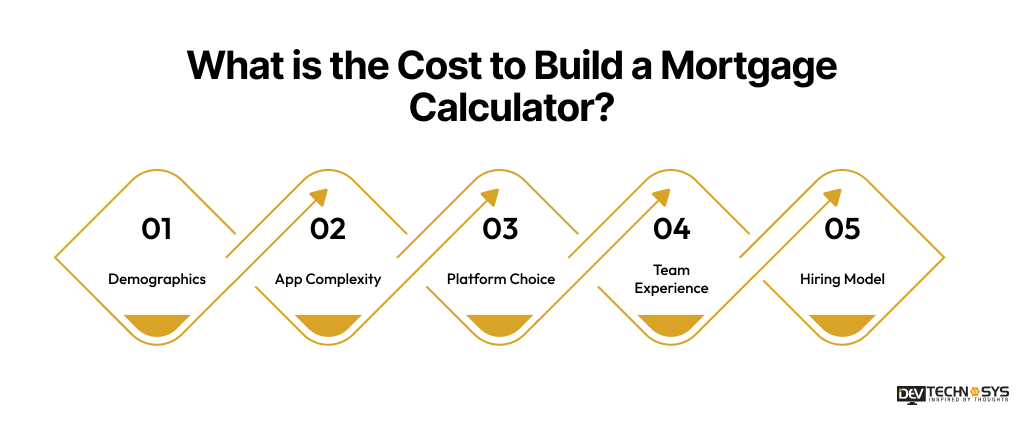
Demographics
The cost to develop a mortgage calculator with design and compliance requirements are impacted by the geography of the target audience. Apps designed for the United States, for instance, could require functionality for regional lending norms, PMI, and property taxes.
| Demographics | Estimated Cost |
| USA | $25000-$30000 |
| Australia | $20000-$25000 |
| India | $5000-$12000 |
| UK | $15000-$20000 |
| UAE | $8000-$15000 |
| Brazil | $12000-$16000 |
App Complexity
The mobile banking app development cost is directly impacted by the quantity of features such as AI-based predictors, credit score integration, and amortization charts. While sophisticated apps with real-time data and analytics are more expensive, a basic calculator is less expensive.
| App Complexity | Development Time | Estimated Cost |
| Simple | 2-5 months | $5000-$10000 |
| Moderate | 5-8 months | $10000-$15000 |
| Complex | 8-12 months | $15000-$20000 |
| Premium | More than 12 months | $20000-$25000 |
Platform Choice
Using cross-platform solutions like Flutter or React Native is less expensive than developing a native app for iOS or Android individually. Although they are less expensive, web-based calculators could not have offline capabilities. Selecting several platforms raises the cost of creation and upkeep.
| Platform Choice | Estimated Cost |
| Native App | $10,000-$15,000 |
| Flutter App | $15,000-$18,000 |
| Hybrid App | $18,000-$20,000 |
Team Experience
Fintech developers that are highly qualified or specialized charge more but provide code that is secure, scalable, and efficient. A team with less experience may save money at first, but mobile app development cost with maintenance charges may increase over time.
| Team Experience | Cost Estimation (USD) |
| Junior/Entry-Level | $8000-$12000 |
| Mid-Level/Experienced | $12000-$16000 |
| Senior/Expert | $16000-$20000 |
| Professional | $20000-$24000 |
Hiring Model
In-house teams provide greater control, but they often have greater overhead and recurring expenses. For short projects, freelancers are more affordable, but they might not offer long-term assistance or scalability. This affects the overall mortgage calculator development cost.
| Hiring Model | Estimated Cost |
| In House Team | $5,000-$8,000 |
| Full-Time Freelancers | $3,500-$5,000 |
| Developer Outreach | $8,000-$15,000 |
How to Monetize Mortgage Calculators?
Businesses may develop a mortgage calculator and use various monetization techniques to make money. These strategies improve user engagement and business growth in addition to increasing profitability:
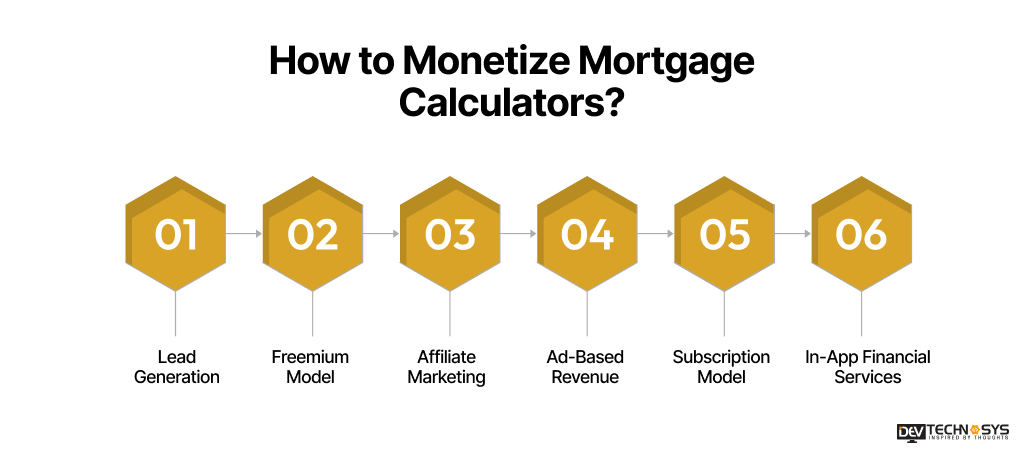
Lead Generation
Use forms to collect user data in return for comprehensive results or personalized loan offers. Leads can be sent to brokers, banks, or real estate brokers, or they can be sold. When used in conjunction with financial institutions looking for suitable prospects, this strategy performs admirably.
Freemium Model
Give away the basic calculator for free, but charge for more advanced features like export options and tax calculations. Upgrades allow users to access ad-free experiences or premium tools. You may find out the cost to develop a mobile app like Tabby to generate revenue and increase brand value.
Affiliate Marketing
A commercial mortgage calculator app advertises third-party insurance companies, credit scoring services, and mortgage lenders. Receive a commission each time a user uses your referral links to apply or sign up. In addition to generating passive money, it benefits users.
Ad-Based Revenue
Use ad networks such as Google AdMob or Meta Audience Network to incorporate interstitials, video advertising, or banner ads. Every impression or click generates revenue, particularly for apps with heavy traffic. You can create a mortgage calculator to enhance user experience with advertisements.
Subscription Model
Charge a regular price for advanced loan comparison analytics, customized reports, or access to premium features. Plans that are monthly or annual promote consistent revenue and long-term involvement. You can build an app like Affirm that gradually draws in and converts users to provide free trials.
In-App Financial Services
Include features like credit checks, insurance estimates, and rapid loan pre-approvals right in the app. Collaborate with fintech companies to receive service fees or commissions. So, businesses must make a mortgage calculator to increase the usability in addition to generating income.
Let’s Summarize!!
For a business investor, it is mandatory to know the cost to build a mortgage calculator. So, it can easily decide on investing in the development process. To understand the role of mobile app development in banking sector in 2025, you must approach an IT consulting company like Dev Technosys because:
- You get a reliable team that has experienced, skilled and reliable developers.
- Access to various services to make a mortgage calculator app.
- Secure and confidential documentation process.
So, if you also want to ensure the success of your loan financing app, then it is profitable to connect us. You will get affordable solutions that will help you to attract customers and generate revenue.
FAQs
Q1. Which are the Best Mortgage Calculators in the USA?
The mortgage calculators offered by Zillow, Bankrate, NerdWallet, and Rocket Mortgage are among the top ones in the United States. These tools are renowned for their precision, usability, and cutting-edge features like real-time offers and amortization.
Q2. How Long Does it Take to Build a Mortgage Calculator?
It can take 2 to 4 weeks to create a simple mortgage calculator, but it can take 8 to 12 weeks or longer to create a feature-rich software. Complexity, platform, and unique design specifications all affect the timeline.
Q3. What is the Rate of Hiring Dedicated Developers?
Prices range from $10 to $30 per hour in Asia, $30 to $45 per hour in Eastern Europe, and $45 to $60 per hour in the US. Another option is to hire developers on a monthly basis, which typically costs between $2,500 and $10,000 per month.
Q4. How Much Does it Cost to Maintain a Mortgage Calculator?
The cost of monthly maintenance ranges from 15% to 20% of the overall development rate. This covers compatibility enhancements, API changes, performance tracking, and bug fixes.
Q5. Do Mortgage Calculators Provide User Data Security?
Yes, safe mortgage calculators adhere to privacy regulations such as the CCPA and GDPR and employ secure APIs and SSL encryption. Applications must have safe access restrictions, data storage, and authentication.
Q6. Which APIs are Used in Mortgage Calculators?
- Interest rate APIs used by Zillow.
- Property tax APIs used by CoreLogic.
- Credit Score APIs used by Equifax.
